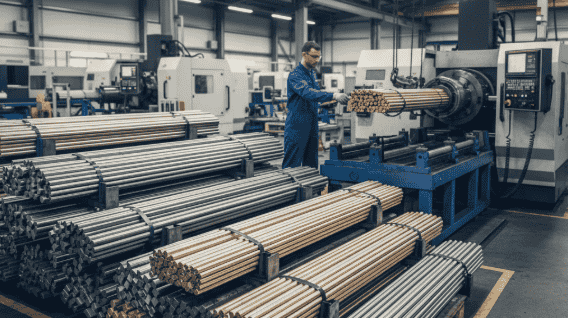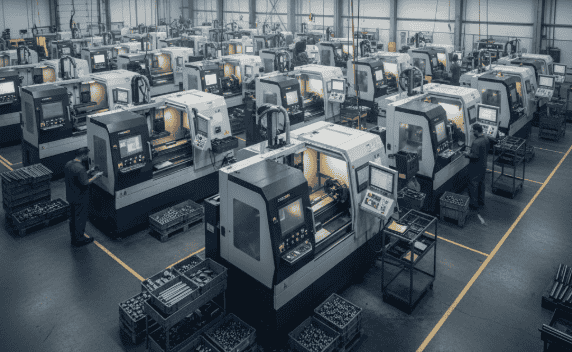What is bar turning?
Bar turning is one of the most valued machining processes in modern industry. Thanks to its ability to mass-produce parts with maximum precision and optimized costs, bar turning shops have become strategic allies for companies in need of reliable industrial components, especially in sectors such as automotive, machinery and technology. In an increasingly demanding industrial market, this technology represents the perfect combination of productivity, cost savings and final quality.
What is bar turning?
In a precision shop, bar turning is a manufacturing process that starts with metal (or engineering plastics) bars or rods that are machined using automatic or computer numerical control (CNC) lathes. The process is designed to produce high-precision parts in large volumes, without sacrificing dimensional quality or surface finish.
Precision bar turning produces complex parts such as screws, shafts, bolts, threaded components or bushings that meet tight tolerances and specific design requirements. This type of machining is applied in sectors where every detail matters:from industrial machinery to automotive, electronics and medical devices, where reliability and accuracy are crucial.
Materials most commonly used in the manufacture of parts by bar cutting

One of the most important factors in the manufacture of parts by bar turning is the choice of material, which defines the properties and the final application of the component.
- Steels: provide hardness, mechanical strength and durability, ideal for fasteners that support heavy loads or machinery parts that require robustness. Carbon, alloy and stainless steels are used .
- Aluminum: offers lightness and resistance to corrosion, characteristics highly valued in sectors such as automotive, electronics or light construction.
- Brasses: recognized for their excellent machinability and good conductivity, they are ideal for electrical components or parts requiring anti-friction properties.
- Technical plastics: such as POM, PEEK or nylon, are machined to create lightweight, insulating components or components with specific wear properties, used in electronics or medical devices.
- The choice of material depends on the final application: while a steel shaft may ensure structural safety in a machine, an aluminum or technical plastic part reduces weight without sacrificing efficiency in an electronic device.
Types of common industrial parts manufactured by bar turning
Bar turning is a versatile technique that allows the manufacture of a wide variety of essential components for various industries.
- Screws and bolts: fundamental threaded elements for temporary or permanent assemblies, offering great versatility.
- Nuts: parts with internal threads that attach to the threaded shank of a screw or bolt, securing the joint. They are manufactured in various shapes and designs, including safety variants.
- Shafts: cylindrical elements used to transmit motion or support rotating components, essential in machinery and transmission systems.
- Bushings: cylindrical parts used to reduce friction, align components or as support, widely used in mechanical systems.
- Connectors and Terminals: electrical or electronic components that require high dimensional accuracy to ensure a reliable and secure connection.
- Hydraulic and Pneumatic Components: parts with tight threads and tolerances, essential for the correct operation of fluid systems.
Types of processes for the manufacture of parts by bar cutting
In modern industry, bar turning processes have diversified to offer tailor-made solutions for every need:
- Single-spindle lathe turning is ideal for the mass production of parts with basic or moderately complex geometries, guaranteeing high repeatability and efficiency.
- Multi-spindle lathe turning is used for the production of large volumes of parts, as it allows several machining operations to be carried out simultaneously, greatly speeding up production.
- CNC (Computerized Numerical Control) turning is an advanced method that allows the manufacture of complex parts with very high precision and very tight tolerances, optimizing time and reducing manual intervention.This is especially relevant for prototypes or short series that require maximum accuracy.
The latter is key to producing high-precision components for sectors such as automotive or medical technology.
Need help?
Contact our technical office and tell us about your project.
We will study your case and propose a solution to manufacture them.
Step by step process: how we manufacture high quality parts by bar cutting
The manufacturing of parts by bar turning follows a rigorous sequence that guarantees quality and precision.
- Material selection: the type of bar or rod (steel, aluminum, brass, technical plastic) is defined according to the final application.
- CNC Design and Programming: the technical drawing is prepared and the CNC machine or automatic lathe is programmed with the machining specifications.
- Material Loading: the bar or rod is fed into the lathe, where it is securely clamped for the process.
- Machining and Forming: cutting tools release material in a controlled manner to shape the part.
- Additional operations: may include tapping, drilling, grooving, knurling or final cutting of the part.
- Quality Control: it is verified that the parts comply with the dimensional tolerances, surface finish and technical standards required by means of precise measurements.
This process makes it possible to obtain large volumes of uniform parts, ready to meet the needs of the industrial sector with maximum reliability.
Advantages of bar turning in the manufacture of industrial parts
Choosing a bar turning shop offers key benefits over other manufacturing methods, boosting the production of any industrial company.
- High Production Speed: especially in mass production, guaranteeing fast deliveries.
- Cost Optimization: by reducing machining times and minimizing material waste.
- Higher Dimensional Accuracy: with tolerances adjusted to international standards, crucial for complex assemblies.
- Versatility of materials: possibility of working with steels, aluminum, brass and technical plastics.
- Guaranteed repeatability: ideal for serial production of homogeneous batches.
- Flexibility: to manufacture from large volumes to short prototyping runs.
Main applications of parts manufactured by bar turning
Metal partsand parts made of other materials manufactured by bar turning are used in a wide variety of industries and sectors:
- Automotive: screws, bolts, shafts, bushings, connectors for engines, bodywork and safety systems.
- Industrial machinery: components for transmission systems, bearings, joints and fasteners.
- Electronics: connectors, terminals, studs and small parts for devices and equipment.
- Energy: precision components for generation and distribution systems.
- Medical Devices: small parts with high quality finishes for instruments and equipment.
- Construction: high-strength fasteners and connecting elements.
Precision turning: innovation at the service of industry
Innovation in precision bar turning not only optimizes production, but also makes it possible to create complex parts that previously required multiple processes or higher costs. With the integration of state-of-the-art CNC technologies and digitization of the process, today’s job shops can produce assembly-ready components, even with high-quality surface treatments and finishes, directly from the machine.
This represents a competitive advantage for companies seeking efficiency, reliability and the highest quality in each manufactured part, ensuring that their products meet the most demanding market standards.

How to request manufacturing or quotation of bar turning parts
If your company needs the manufacture of industrial parts by bar turning, it is advisable to contact our technical office so that we can provide you with the best solution for your needs:
- Let’s analyze your specific needs and the technical requirements of the parts.
- Select the appropriate material (steel, aluminum, brass, technical plastic, etc.).
- Let us design or adapt the machining process and CNC programming.
- Specify finish grades, dimensional tolerances and lead times.
¿ Need help?
Contact our technical office and tell us about your project.
We will study your case and propose a solution.
Frequently asked questions about bar turning FAQ’s
What differentiates bar turning from other machining processes?
Bar turning specializes in mass production of small and medium-sized parts with high precision and cost optimization, while other processes may be less efficient in volume or for parts with very strict dimensional requirements.
What materials can be machined in bar turning?
Mainly steels (carbon, alloy, stainless), aluminum, brass and technical plastics such as POM, PEEK or nylon, depending on the industrial application.
Is bar turning profitable for short series or prototypes?
Yes, although bar turning optimizes costs in large volumes, modern CNC shops offer flexible and cost-effective solutions for short series and high-precision prototyping.
Which sectors demand more precision bar turning services?
The automotive, industrial machinery, electronics, energy, telecommunications and medical device industries are some of the sectors that use bar turning the most due to their need for precision and mass production.
Why should I choose LEMEC as a bar turning shop in Spain?
LEMEC is a workshop specialized in precision bar turning and mass production of industrial parts. With extensive experience and advanced CNC technology, LEMEC guarantees high quality components, cost optimization and on-time delivery. For companies looking for a reliable partner in industrial machining in Spain, LEMEC is the ideal choice.